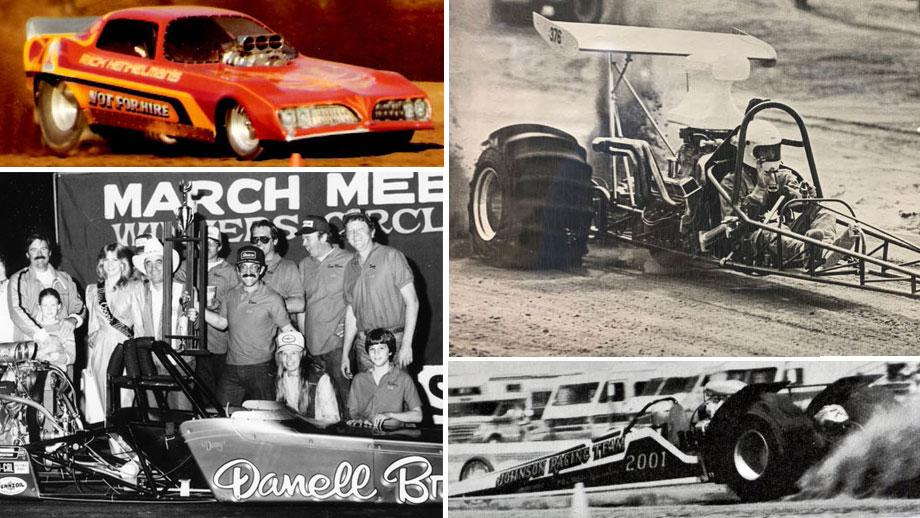Spurred by my last column’s tribute to Jim DePasse, who came to NHRA drag racing via the sand drag route, crystalized in my memory an interesting time in drag racing when sand racers defected in huge numbers to the asphalt in the early 1980s and introduced us to future world champions like Alan Johnson and Gary Scelzi and a slew of talented racers like Danny Danell, Rick Henkelman, Bruce McDowell, Steve Faria, Mitch Myers, Butch Blair, and many others who became NHRA regulars. I can’t remember a bigger mass-scale invasion from another form of motorsports.
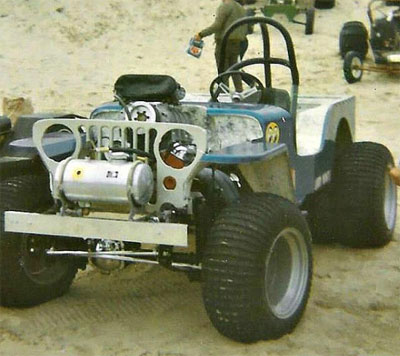
Although Johnson and Scelzi were from Central California, Ground Zero for sand drag racing was (and continues to be) the Hemet/San Jacinto region in the desert east of Los Angeles, which was home to potato-farming magnate Larry Minor, who was the first major name to leave the sand for asphalt in 1977 and certainly went on to become one of the most successful of the asphalt converts (although he, like DePasse, returned to his sand roots recently).
Minor has been sand drag racing since 1959, starting on the sand dunes in Glamis, Calif., and by the early 1960s had a Chevy 409 -powered Jeep that won a slew of events and in 1966 introduced the first fiberglass four-wheel-drive Jeep powered by a blown 352 small-block Chevy with nitro in the tank. Known as “Flower Power” (hey, it was the ‘60s), the Jeep dominated the unlimited class for the next four years.

In 1971 upped the ante by building a Top Fueler and a Funny Car, both motivated by aluminum 500-cid blown and injected nitro engines (Milodons) and introduced the dual paddle rear tires still run today. Minor remained unbeatable during the decade before he went to the asphalt and fielded Top Fuelers driven by Larry Bowers (briefly), then Larry Dixon Sr. and Gary Beck, the latter of whom went on to break just about every performance record in 1983 en route to the world championship. Of course, Minor went on to add a Funny Car driven by Ed McCulloch and another Top Fueler driven by Minor, all of which won events, signed a major sponsorship with McDonald’s, and gave Cruz Pedregon his first serious leg up in the nitro ranks. Pretty good career, right?
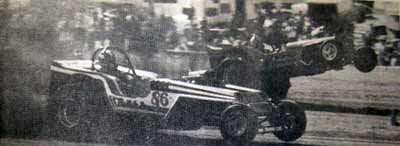
Minor’s asphalt success probably was not unexpected to his sand drag pals as he was a) well-funded and b) always pushing the performance envelope. Hemet neighbor DePasse, whose nitro-fueled blown 392-powered Fuelish Pleasure Jeeps were also winners, followed in 1979 with a Monza Funny Car with pal Willie Wolter, but the mass migration didn’t really begin until 1981, which is the real subject of this column.
I actually did a feature story on the subject in National Dragster in 1985 (with the regrettable but memorable title: “Do You Know The Way From Sand, Jose?”) that provided a lot of background (and photos) for this column but I nonetheless began my trip back through the sands of time (see what I did there?) with a call to Henkelman, who is one of the few (him and Faria, I guess) still out there racing with us.
Henkelman, who first competed in NHRA with an Alcohol Funny Car and then went on to win three national events in Top Alcohol Dragster (and later partnered with David Baca in Top Fuel), no longer drives, but today owns and tunes the very competitive Boost Performance Products A/Fuel Dragster driven by Garrett Bateman to a trio of national event wins in Las Vegas. Although he’s a NorCal guy now, he also had his roots in Hemet.
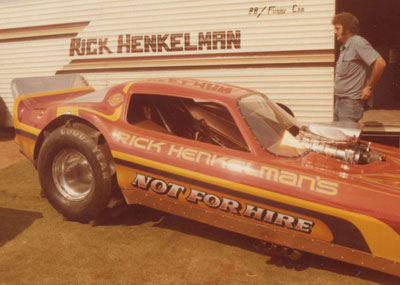
Henkelman’s car caught my eye at my first (and only) sand drag adventure out to the American Sand Racing Association event in Hemet in (guessing) 1981 with my good pal and future automotive media bon vivant C. Van Tune, whose family owned a home in Hemet at the time. The color photos here are mine.
Henkelman’s Not For Hire Trans Am Alcohol Funny Car – an ex-Gary Densham Teacher’s Pet AA/Funny Car -– just looked bad-ass with a low-slung body and those wild paddle tires. I didn’t realize it until I talked to Henkelman last week, but those trademark sand tires –- singles for alcohol and dual tires for nitro — all began life as Goodyear asphalt slicks that were ground down and the paddles manually vulcanized onto them.
The Trans Am was actually Henkelman’s second sand flopper after wadding up his first car, an ex-Ed McCulloch Revollution, after a stuck throttle/24-barrel-roll down the track at his first event.
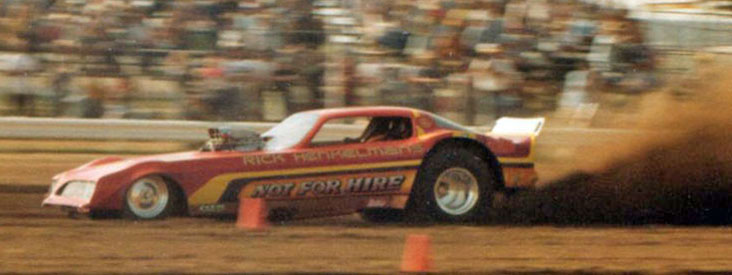
Henkelman ended up doing really well in ASRA competition, winning the championship three straight years (1980-’82) in the Alcohol Funny Car class before moving into NHRA competition in 1983.
“We had a lot of fun; it was very family-oriented, with a lot of motorhomes,” he remembered. “That was a very close group but it came to a point where everybody of consequence moved to the asphalt. We felt like it was going from nowhere to somewhere really important. It was just what we needed to do; we needed to move up, and you really didn’t need to do anything other than change the rear tires to move over to the asphalt. Even though the sand track is only 300 feet, we didn’t even have to change the gearing for the quarter-mile because we used to leave in 2nd gear on the sand. And once we got [to the asphalt] there was never a thought to going back.”

Today, Alan Johnson is one of the indisputable leaders of the performance parade in the NHRA nitro world, and the lessons that he and his brother, Blaine, learned on the sand, starting with a four-wheel-drive pickup and then progressively faster dragsters, have paid off. A.J. was hands-on from the beginning, building his own dragster chassis and learning how to do it himself rather than relying on hired talent.
“We learned how to develop a tune-up, how to organize a team, and about competitiveness and we applied the same concepts when we came to NHRA,” he said. “We did it all ourselves; we took the money we would have spent on a tuner and spent it on parts instead.”
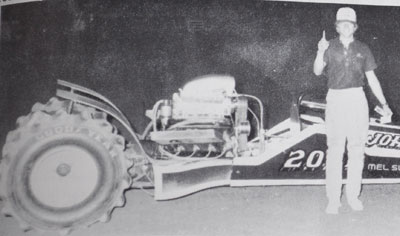
Blaine, who would go on to become a four-time NHRA world champion in Top Alcohol Dragster only got to drive the sand car a few times as he was just getting licensed when the team made the jump to asphalt in 1982. Alan drove for the first couple of years before Blaine took over in 1988.
“I think that going to NHRA was probably internally the goal the whole time,” he admitted. “When we felt we were ready, we made the change. It was a little rough to begin with but we worked out the kinks and became pretty successful.”
People know A.J. as a tuning whiz but he also was solid behind the wheel in the sand drags, winning repeatedly and, in 1979, going undefeated until the final race of the season where he lost in the final round. Johnson also match raced – and often beat – Top Fuel sand rails with his alky burner.
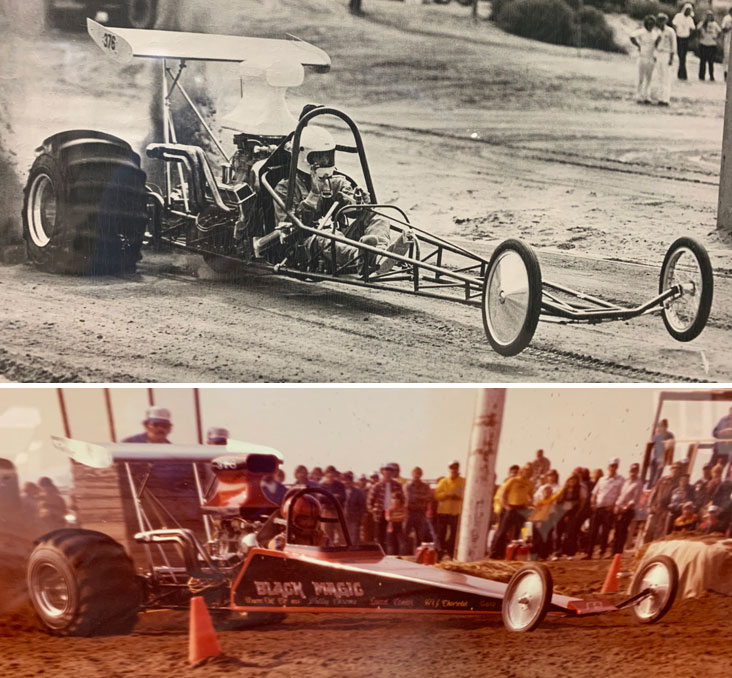
For Gary Scelzi, the attraction of asphalt racing was easy: he just wanted to do a burnout, which didn’t exist in sand racing. Scelzi began sand racing in 1976, as soon as he turned 16, and raced the bodyless small-block Chevy-powered dragster shown above in the B/Pro Comp class (maximum displacement of 388 cubic inches) and later in A/Pro Comp before making the move to the asphalt in 1982 with his sand car.
“People started leaving to go to the asphalt, and there was nobody to race anymore, so I decided we should go, too,” he remembers. “The only problem is that my dad and my brothers didn’t want to do it, but they gave me the truck, trailer and the car. I got the green light knowing there wasn’t a chance in hell to do good over there. I knew my stuff was junk. We lengthened it and did a back half but it was still not good.
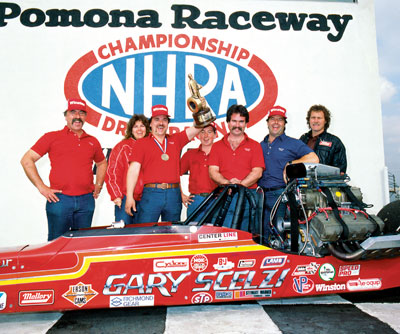
“Because we only ran 100 yards on sand, you had to be good on the Tree, and I could really knock the Tree down, and I made it to a lot of finals because of that. When we switched to asphalt that was always an advantage to me and, because you were driving the car for so much longer, it was easy to hit my shift points. I could get the early lead but people would drive around me after that.
“Tom Boghosian, Bob Wyman, and Bob DeVour used up all of their favors to help me. They told me to sell everything I had to get a Brad Anderson engine, which at the time cost $30,000; it might as well have been $30 million because I didn’t have 30 grand. I sold all of my junk stuff and still was 5 grand short. Brad told me if I put the engine in I would make 5 grand right away and kept me going while I burned stuff up. We ended up winning the World Finals and I was able to pay back Brad for everything.”
As mentioned earlier, although Minor, Johnson, and Scelzi are the most successful sand transplants, there are a whole host of other names now recognizable to NHRA fans who showcased their skills on the sand.
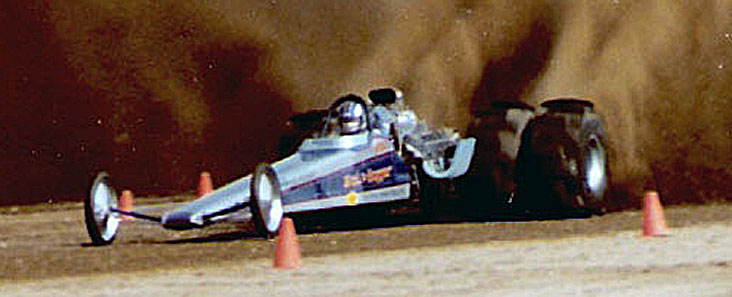
Chuck Neal, who went on to race Alcohol Dragsters and now competes in the NHRA Hot Rod Heritage Series, “was a bad-ass, one of the kings,” according to Scelzi, and while online documentation is pretty thin on those days, it’s clear that Scelzi was not exaggerating. In addition to multiple Top Fuel titles, Neal, who was partners with Bill Hopper, who had been Ted Cyr’s partner when Cyr won the 1958 Nationals in Oklahoma City, also drove the Neal & Hopper to the sport’s first 2.5-second pass, a 2.587, wayback in 1980 at Southern California’s Riverside Raceway.
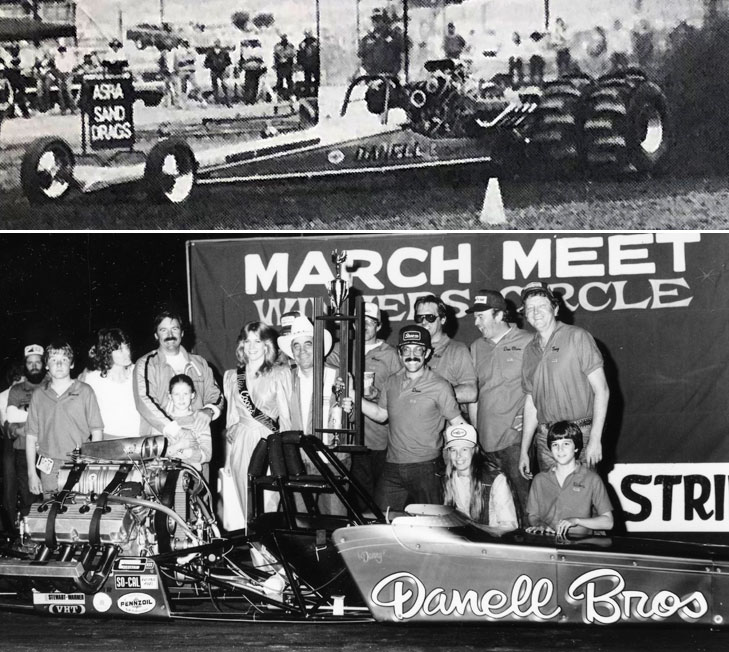
Danny Danell will be forever remembered as the stunning Top Fuel winner of the 1983 March Meet not long after switching to asphalt. Danell won the final over Shirley Muldowney on a holeshot, no doubt putting the sand-racing reflexes that Scelzi mentioned to good use, but the Danell brothers’ success was no surprise to those who faced them on the sand. Their Avenger AA/BAD was a championship-winning terror on the sand and then carried them to back to back Top Fuel championships. Their Top Fuel car was so powerful that it routinely broke rear ends on practically every run before they began employing a diesel-truck-style rear end, prepared for them by Chrisman Driveline Components, that had a longer lifespan.

Steve Faria is another successful sand racer who also has enjoyed his moments of success on the asphalt. Faria’s “Banzai”/Faria Farms dragster was a class record holder and, of course, when he came to NHRA he forever etched his name in the history books as the driver of the first five-second Alcohol Dragster. Faria continues to compete today, running a part-time schedule in Top Fuel.

Butch Blair, better known to NHRA fans for his Blair’s Fugowie Top Fueler, raced in both Top Fuel and Funny Car on the sand, the latter at first with the ex-Larry Minor machine and then an aluminum-bodied Woody with a blown fuel Arias for power, leading some to christen him “the ‘Jungle Jim’ of the sand.” He later switched to Top Fuel, with an engine out of the Shaw Outlaw flopper and won the 1984 National Sand Competition Association Top Fuel title.

Mike O’Hearn had a good run in NHRA Alcohol Funny Car competition after winning championship in both a dune buggy and Alcohol Funny Car on the sand. He can lay claim to the first sub-three-second Alcohol Funny Car pass on sand and was credited with being one of the first to run a braking parachute on the sand. After winning the ASRA championship in 1982, he switched to the asphalt and set low e.t. and won the race at Fremont Raceway’s Nitro Bowl opener in 1983. Mike Grieco bought O’Hearn’s sand car, ran it for a year, then commissioned Sherm Gunn to build him a state-of-the-art Camaro for the asphalt wars. His M&I Guns entry was a strong runner and he gained widespread notoriety by loaning it to Brad Anderson to win the 1983 World Finals after Anderson crashed his car just before the event.
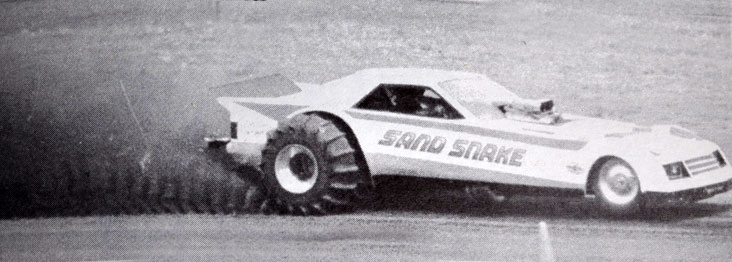
Mitch Myers, the 2004 NHRA Lucas Oil Drag Racing Series Top Alcohol Dragster champion, also fulfilled his first need for speed on the sand, going from a blown gas Jeep in 1977 and then to BB/FC in 1978 and won the championship 1978-79. In 1980 he switched to nitro and set the national record on his second pass and won the championship in 1982-83 with his Sand Snake Mustang, then switched to asphalt in 1985. Myers, who shocked the world with quarter-mile elapsed times of 5.109 and 5.118 during the 2004 NHRA Finals then walked away from driving after winning the championship, returned to the cockpit earlier this year at the Denso Spark Plugs NHRA Four-Wide Nationals in Las Vegas.

Ralph Pearson first went sand drag racing in 1978 and set the AA/FC national records in two sanctioning bodies and won 10 straight races in 1980. In 1981 he switched to Top Fuel and was championship runner-up behind Danell in 1981. He moved to asphalt in 1983.

Wyatt Radke, who went on to have a journeyman career in the NHRA nitro Funny Car ranks for a slew of owners, and Dean Shaw, whose son, Mike would drive their Rampage Alcohol Funny Car on the asphalt, teamed up in the early 1980s with Dan Toste to run a nitro Funny Car on the sand, a wild, rear-engined Dodge Challenger dubbed Outlaw, that they bought from Pearson. Shaw actually had been an asphalt racer since the early 1960s who went the other way to the sand in 1981 for a few years.
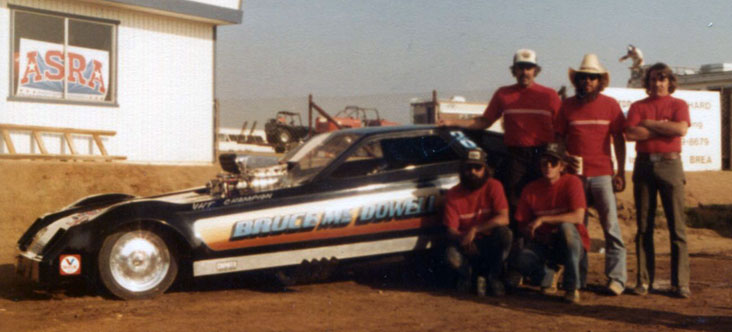
Bruce McDowell won six NHRA races in the Top Alcohol Dragster class from 1984 through 1988 after a successful sand career that began with a two-engined, VW-powered dragster before moving up to Alcohol Funny Car and won the 1981 ASRA championship. He moved to NHRA in 1982.
I’m sure that I just scraped the surface of this list, and apologies to anyone I’ve left off but it’s clear that, for many, the road to NHRA success did indeed find its way from sand, Jose.
Phil Burgess can reached at pburgess@nhra.com
Hundreds of more articles like this can be found in the DRAGSTER INSIDER COLUMN ARCHIVE

